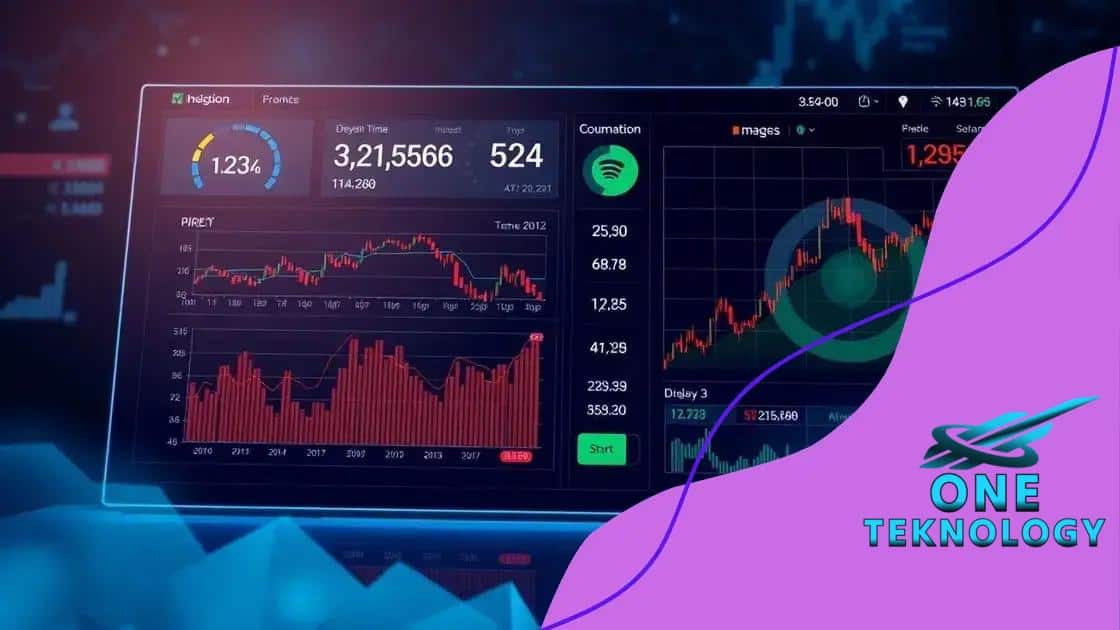Real-time financial data and its impact on investment decisions

Real-time financial data provides live updates on market conditions, enabling investors to make timely and informed decisions to optimize their trading strategies and enhance profitability.
Real-time financial data significantly influences investment decisions by providing investors with up-to-date information. Have you ever wondered how this immediacy affects your choices on the stock market? Let’s explore.
Understanding real-time financial data
Understanding real-time financial data is crucial for investors making informed decisions. This data provides updates on stock prices, market trends, and economic news as they happen. With access to real-time data, investors can react quickly to changes in the market, improving their chances of making profitable trades.
What is Real-Time Financial Data?
Real-time financial data refers to information about financial markets that is available instantly. This includes stock quotes, market indices, and news reports. The immediacy of this data allows traders to understand the market dynamics as they unfold.
Benefits of Using Real-Time Financial Data
Investors who utilize real-time financial data enjoy several advantages:
- Timely Decisions: With immediate updates, investors can make timely decisions that can affect their investment outcomes.
- Market Insight: Real-time data offers insights into market trends and fluctuations, helping investors identify opportunities.
- Competitive Edge: Accessing data quickly allows investors to stay ahead of their competition.
As we analyze the impact of real-time financial data, it becomes clear that understanding it is essential for navigating the complexities of today’s markets. Investors who are well-informed can adjust their strategies based on the latest information available. Knowledge of such data can lead to smarter decisions and better investment outcomes.
Furthermore, the technologies that deliver this data, such as trading platforms and financial news services, are continually evolving. Many investors rely on applications that provide alerts and real-time analytics, ensuring they are never caught off guard by sudden market shifts.
Understanding how to interpret and utilize real-time financial data can significantly enhance an investor’s ability to manage their portfolio effectively. Combining this knowledge with analytical tools can create a robust investment strategy.
Benefits of real-time data in investments
The benefits of real-time data in investments are significant. Investors who leverage this data can gain a better understanding of market conditions, allowing them to make informed decisions swiftly. Access to timely information often leads to increased profits and minimized risks.
Immediate Insights
One of the greatest benefits of real-time data is the ability to receive immediate insights into market movements. This quick access enables investors to act fast when opportunities arise or to mitigate losses. For example, if a stock price suddenly drops due to news, an investor can quickly decide to sell before losses accrue.
Enhanced Decision Making
Investors can enhance their decision-making by using real-time financial data. With real-time information, they can analyze trends and patterns that might not be visible in outdated data.
- Market Volatility: Real-time data helps investors understand and adapt to sudden changes in market conditions.
- Trend Analysis: Continuous updates allow for better trend analysis, aiding long-term strategies.
- Informed Trading: Investors can make informed trades by watching live price changes and market news.
Utilizing real-time financial data not only improves the speed of transactions but also helps build a more responsive investment strategy. Investors become more agile in their trades, adapting to shifts in the market as they happen. This adaptability is essential in a rapidly changing financial landscape.
Moreover, by actively monitoring data, investors often feel more in control. The result is a more proactive investment approach, as they can anticipate market movements rather than react to them later. As the market continues to evolve, embracing real-time data is key to staying competitive.
How to access real-time financial data

Knowing how to access real-time financial data is crucial for any investor. With the right tools, anyone can tap into valuable market information to make informed decisions. Access typically requires using specific platforms or services.
Online Trading Platforms
One of the most common ways to access real-time financial data is through online trading platforms. These platforms offer live updates on stock prices, charts, and market news, allowing users to track investments effectively.
- Brokerage Websites: Many brokerage firms provide clients with access to real-time data as part of their trading services.
- Mobile Apps: Many apps allow trading on-the-go. They often include alerts for price changes and news.
- Desktop Software: Platforms like MetaTrader or ThinkorSwim provide robust tools for analysis and real-time data tracking.
Using these tools, investors can monitor their portfolios in real time. This helps them respond quickly to market changes and opportunities, making trades based on up-to-date information.
Financial News Services
Another way to gain access is through financial news services that specialize in delivering real-time financial data. These services provide updates on significant market movements and global economic news.
Many investors subscribe to these services because they include:
- Breaking News Alerts: Get notified about important news affecting the markets.
- Market Analysis: Expert analyses help in understanding the implications of the data.
- Live Commentary: Real-time commentary from financial analysts can provide insights during trading hours.
Furthermore, many social media platforms now offer real-time data sharing. Financial experts and companies often share insights, news, and trends on platforms like Twitter and LinkedIn. By following key accounts, investors can stay informed about market developments as they happen.
In conclusion, there are several avenues to access real-time financial data. Whether through online trading platforms, financial news services, or social media, the options are numerous. With the right resources, investors can enhance their trading strategies and make well-informed financial decisions.
Impact of technology on data analysis
The impact of technology on data analysis is profound. Technology has transformed the way investors interpret and use data to make decisions. With the arrival of new tools and software, analysis becomes faster, smarter, and more efficient.
Advanced Analytical Tools
Modern analytical tools allow investors to process large amounts of data quickly. These tools use algorithms and artificial intelligence to analyze trends and predict future movements. Investors can, therefore, focus on strategies rather than just data collection.
- Data Visualization: Tools like Tableau or Power BI help in creating visual representations of complex data, making it easier to interpret.
- Predictive Analytics: By using historical data, investors can forecast future scenarios, leading to better decision-making.
- Machine Learning: This technology enables systems to learn from data over time, improving their accuracy in predictions.
As these advanced tools evolve, they make it simpler for all types of investors to analyze trends and patterns. For example, a trader can quickly see how a stock has performed in the past and anticipate how it might behave in the future.
Real-Time Data Processing
The ability to analyze real-time financial data has changed the investment landscape. Technology now allows for immediate assessments of market conditions. Investors can react promptly to new information, adjusting their strategies on the fly.
This immediacy fosters a dynamic market environment where opportunities may arise and disappear within minutes. As such, investors equipped with the right technology can capture these fleeting chances.
Moreover, cloud computing has made it easier to access data from anywhere, allowing investors to perform analyses on the go. This mobility means that crucial decisions can be made without being tied to a desk, leading to more active trading strategies.
Ultimately, the impact of technology on data analysis continues to reshape investing. With each advancement, investors gain improved tools to understand complex markets, making informed and timely decisions that align with their financial goals.
Case studies: success stories using real-time data
Examining case studies of success stories using real-time data reveals how various companies have leveraged this information to achieve significant gains. These examples highlight the transformative power of immediate insights in decision-making.
Example 1: Retail Industry
A major retail chain implemented a real-time inventory system that tracks stock levels as they change. By utilizing real-time data, the company could quickly identify which products were selling the best. This allowed them to adjust their inventory and supply chain accordingly, resulting in a substantial increase in sales.
Example 2: Financial Services
In the financial sector, a leading investment firm adopted real-time data analytics for trading. By integrating advanced algorithms and market feeds, the firm began to predict stock movements with higher accuracy. This led to numerous profitable trades and enhanced overall portfolio performance.
- Immediate Adjustments: The ability to react instantly to market changes allowed the firm to minimize losses.
- Informed Strategies: Real-time insights improved their decision-making process, leading to better long-term strategies.
- Increased Profit Margins: Quick access to data translated into improved profit margins during volatile market conditions.
Another notable case study is in the health sector. A hospital utilized real-time data to optimize patient flow and resource allocation. By analyzing patient admission data as it happened, they could predict peak times and staff accordingly.
This proactive approach resulted in shorter wait times and improved patient satisfaction. The use of data not only enhanced service delivery but also significantly lowered operational costs.
These case studies exemplify how organizations across diverse sectors are embracing real-time data. By integrating these insights into their operations, companies can drive efficiency, enhance customer satisfaction, and ultimately bolster their bottom line.
FAQ – Frequently Asked Questions about Real-Time Financial Data
What is real-time financial data?
Real-time financial data refers to live updates of market information, including stock prices, indices, and economic indicators.
How can real-time data affect investment decisions?
Access to real-time data allows investors to make quick and informed decisions, seizing opportunities and minimizing losses.
What tools can I use to access real-time financial data?
You can use online trading platforms, financial news services, and mobile apps to access real-time financial data effectively.
Are there examples of success using real-time data?
Yes, case studies show that retailers have optimized inventory, and financial firms have increased profits by leveraging real-time data for their strategies.






